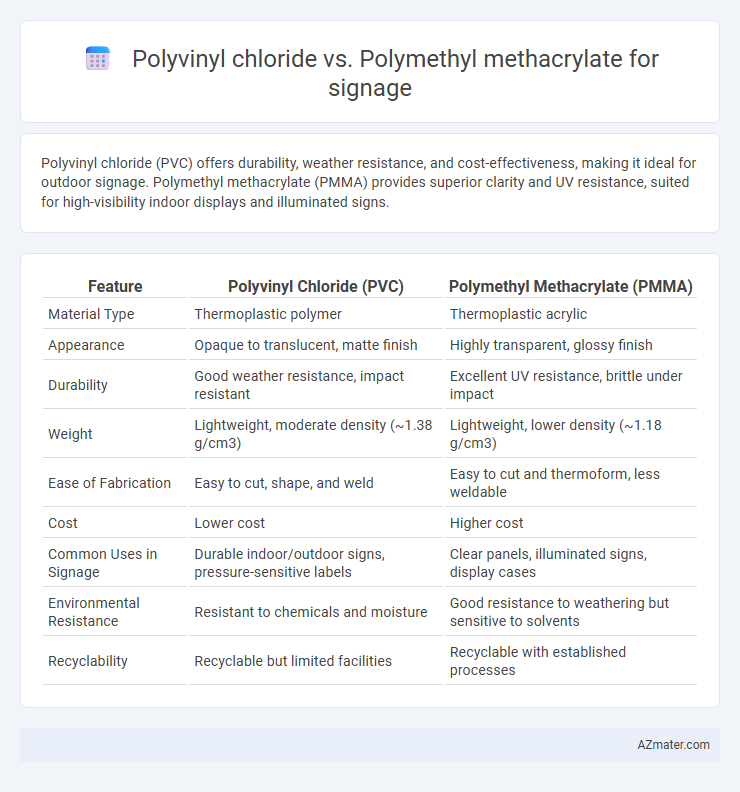Polyvinyl chloride (PVC) offers durability, weather resistance, and cost-effectiveness, making it ideal for outdoor signage. Polymethyl methacrylate (PMMA) provides superior clarity and UV resistance, suited for high-visibility indoor displays and illuminated signs.
Table of Comparison
| Feature | Polyvinyl Chloride (PVC) | Polymethyl Methacrylate (PMMA) |
|---|---|---|
| Material Type | Thermoplastic polymer | Thermoplastic acrylic |
| Appearance | Opaque to translucent, matte finish | Highly transparent, glossy finish |
| Durability | Good weather resistance, impact resistant | Excellent UV resistance, brittle under impact |
| Weight | Lightweight, moderate density (~1.38 g/cm3) | Lightweight, lower density (~1.18 g/cm3) |
| Ease of Fabrication | Easy to cut, shape, and weld | Easy to cut and thermoform, less weldable |
| Cost | Lower cost | Higher cost |
| Common Uses in Signage | Durable indoor/outdoor signs, pressure-sensitive labels | Clear panels, illuminated signs, display cases |
| Environmental Resistance | Resistant to chemicals and moisture | Good resistance to weathering but sensitive to solvents |
| Recyclability | Recyclable but limited facilities | Recyclable with established processes |
Introduction to Polyvinyl Chloride (PVC) and Polymethyl Methacrylate (PMMA)
Polyvinyl Chloride (PVC) is a versatile thermoplastic widely used in signage due to its durability, weather resistance, and cost-effectiveness, making it ideal for both indoor and outdoor applications. Polymethyl Methacrylate (PMMA), also known as acrylic, offers superior optical clarity and UV resistance, making it suitable for high-quality, visually appealing signs that require long-lasting transparency and color vibrancy. Both materials provide distinct benefits for signage manufacturers, with PVC favoring flexibility and affordability, while PMMA excels in aesthetic appeal and light transmission.
Material Composition and Properties
Polyvinyl chloride (PVC) consists primarily of vinyl chloride monomers and offers excellent durability, chemical resistance, and flexibility, making it ideal for outdoor signage. Polymethyl methacrylate (PMMA), also known as acrylic, is composed of methyl methacrylate monomers and provides superior optical clarity, UV resistance, and rigidity. PVC suits applications requiring impact resistance and weatherproofing, while PMMA excels where transparency and aesthetic appeal are critical.
Durability and Weather Resistance
Polyvinyl chloride (PVC) offers excellent durability and weather resistance with strong resistance to moisture, chemicals, and UV radiation, making it highly suitable for outdoor signage. Polymethyl methacrylate (PMMA), also known as acrylic, provides superior clarity and maintains color vibrancy but is more prone to scratching and can degrade under prolonged UV exposure without protective coatings. For long-term outdoor signage applications requiring robustness against harsh weather, PVC generally outperforms PMMA in maintaining structural integrity and visual appeal.
Visual Appearance and Aesthetics
Polyvinyl chloride (PVC) offers a matte finish with good color vibrancy and durability, making it ideal for cost-effective, long-lasting outdoor signage. Polymethyl methacrylate (PMMA), also known as acrylic, provides superior clarity, gloss, and light transmission, delivering a sleek, high-end appearance ideal for premium signage applications. PMMA's resistance to yellowing and its smooth surface contribute to a visually striking aesthetic, whereas PVC is favored for its versatility and affordability in various sign designs.
Weight and Handling Considerations
Polyvinyl chloride (PVC) is significantly lighter than polymethyl methacrylate (PMMA), making it easier to transport and install for large signage applications. PVC's flexibility enhances handling and reduces the risk of cracking during installation, whereas PMMA is more rigid and prone to breakage under stress. The weight advantage of PVC enables cost savings in shipping and quicker mounting, especially on large or overhead displays.
Printability and Customization Options
Polyvinyl chloride (PVC) offers excellent printability with its smooth surface, enabling vibrant, long-lasting colors ideal for outdoor and indoor signage. Polymethyl methacrylate (PMMA), also known as acrylic, provides superior customization options, including laser cutting and engraving, which allow for intricate designs and clear, glossy finishes. While PVC is cost-effective and durable, PMMA excels in clarity and aesthetic appeal, making the choice dependent on the signage's visual requirements and environmental exposure.
Cost Comparison: PVC vs PMMA
Polyvinyl chloride (PVC) offers a significantly lower cost per square foot compared to Polymethyl methacrylate (PMMA), making it a budget-friendly option for large-scale signage projects. PMMA, known for its superior clarity and weather resistance, commands a higher price due to its enhanced durability and aesthetic appeal. Businesses seeking cost-efficiency often prefer PVC, while those requiring premium finish and longevity may invest in the higher upfront cost of PMMA.
Environmental Impact and Sustainability
Polyvinyl chloride (PVC) poses significant environmental concerns due to its production process releasing harmful dioxins and its non-biodegradable nature, leading to persistent landfill waste in signage applications. Polymethyl methacrylate (PMMA), or acrylic, offers a more sustainable option with better recyclability and lower toxicity during manufacturing, reducing its ecological footprint. Choosing PMMA for signage supports greener practices by minimizing hazardous emissions and enabling material recovery, aligning with sustainable development goals.
Application Suitability for Signage
Polyvinyl chloride (PVC) offers excellent durability and weather resistance, making it suitable for both indoor and outdoor signage that requires long-term exposure to elements. Polymethyl methacrylate (PMMA), also known as acrylic, provides superior optical clarity and UV resistance, ideal for illuminated and high-visibility signage where vibrant color and light transmission are crucial. For applications demanding robust impact resistance and cost-effectiveness, PVC is preferred, while PMMA excels in aesthetic appeal and light diffusion for premium signage solutions.
Conclusion: Choosing the Right Material for Your Signage Needs
Polyvinyl chloride (PVC) offers durability, cost-effectiveness, and ease of fabrication, making it ideal for long-lasting outdoor signage. Polymethyl methacrylate (PMMA), known as acrylic, provides superior clarity, UV resistance, and a high-gloss finish, perfect for vibrant, high-impact display signs. Selecting between PVC and PMMA depends on weighing budget constraints, environmental exposure, and desired visual appeal to ensure optimal signage performance.

Infographic: Polyvinyl chloride vs Polymethyl methacrylate for Signage
 azmater.com
azmater.com